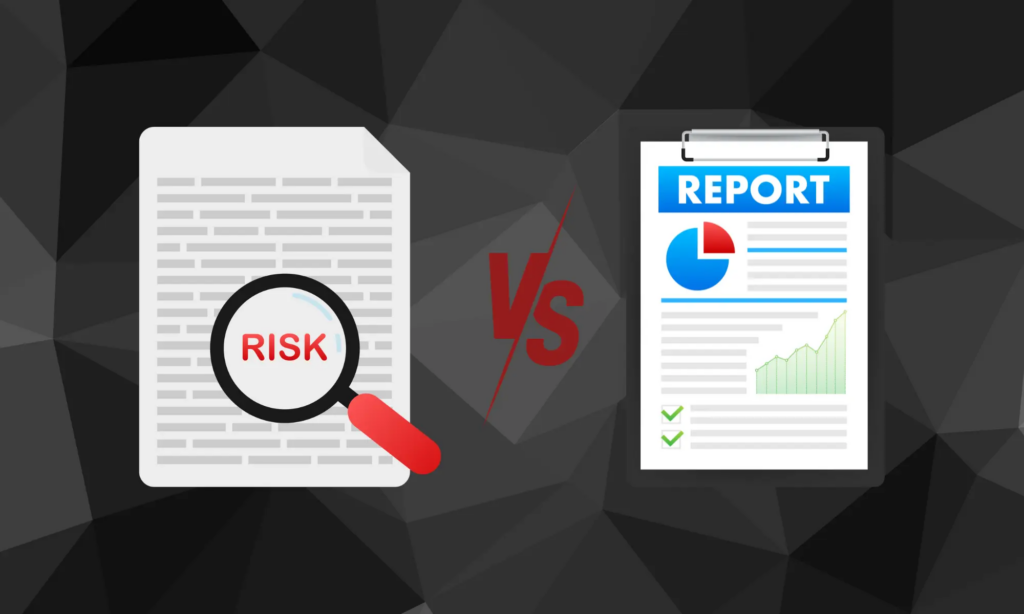
You may have heard DPIA and PIA thrown around here and there, but what’s the difference between DPIA vs PIA? Well, you’ve come to the right place to figure that out.
This article delves into both DPIA (Data Protection Impact Assessment) and PIA (Privacy Impact Assessment), exploring their importance, distinctions, and implications for businesses.
These evaluations ensure data usage and security. Join me as we explore these assessments together.
Let’s dive right in.
Key Takeaways
DPIA and PIA serve as tools for safeguarding data within businesses. They act as resources guiding businesses on how to prevent data-related issues.
While DPIA is specifically associated with Europe’s GDPR regulations, PIA finds usage in countries like the United States and Canada. Both tools play a role in helping businesses adhere to data regulations while maintaining the trust of their consumers.
Proper preparation is essential. Businesses should assess whether they require these assessments, evaluate the data they have, and seek advice from Captain Compliance. This ensures compliance with regulations and fosters an environment for data protection.
What is a DPIA?
What is a DPIA (3).png
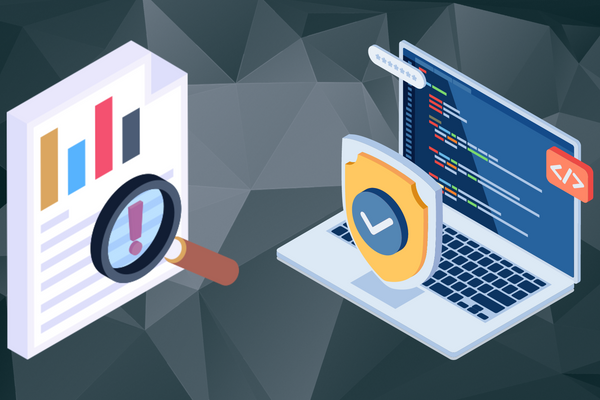
A Data Protection Impact Assessment (DPIA) serves as a safety measure for businesses to ensure the handling of personal data.
It involves documenting and evaluating any risks associated with the use and storage of data. This practice holds significance as it allows businesses to follow regulations and safeguard information from harm.
Now, why do businesses do DPIAs? Well, it’s actually mandatory under the General Data Protection Regulation (GDPR), which took effect in 2018.
According to this regulation, if a business intends to use data in a manner that poses high risks, it must first conduct a DPIA as outlined by Article 35 of the GDPR.
Think of it as a roadmap that identifies any obstacles or hazards along the way. The DPIA is typically conducted by a privacy team like Captain Compliance or a data protection officer (DPO).
Should any issues arise during your DPIA, you should devise strategies to address them. This proactive approach ensures everyone’s information is safe and private.
What is a PIA?
What is a PIA.png
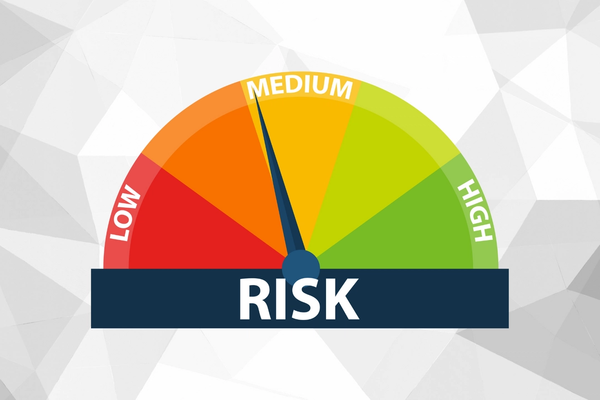
A Privacy Impact Assessment (PIA) is similar to a verification that businesses undergo to assess how they handle individual’s personal information.
It serves as a tool for businesses to evaluate whether they are using data in an ethical manner. The significance of a PIA lies in its ability to assist businesses in ensuring compliance with privacy regulations.
In the United States, certain state regulations mandate that specific businesses conduct a PIA. Additionally, the PIPEDA in Canada requires PIAs in certain cases.
This assessment examines aspects, including the nature of the data used its purpose, and how it is shared. Its primary objective is to identify any issues or concerns and take measures.
The responsibility for conducting this evaluation falls upon the DPO or the team within businesses entrusted with data management and privacy matters.
If any issues are identified during this process, appropriate solutions are implemented. This comprehensive approach not only safeguards individual data but also ensures that businesses operate.
Differences Between DPIA vs PIA
Differences Between DPIA vs PIA.png
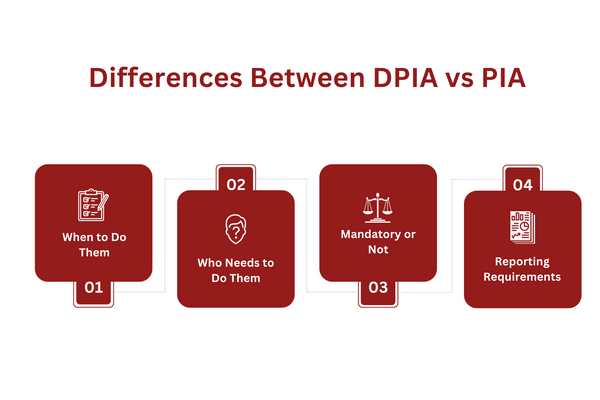
These assessments are employed by businesses to ensure the proper handling of data, but they have differences. Let’s explore further to understand what sets them apart:
When to Do Them
DPIAs are primarily conducted prior to implementing new technology systems and business processes. Under the General Data Protection Regulation (GDPR), it’s mandatory when data processing is likely to result in a high risk to people’s personal information.
However, PIAs can be done at various stages of planning an initiative involving personally identifiable information – from initial feasibility assessments through final testing before launch.
Who Needs to Do Them
DPIAs are often associated with a regulation known as the General Data Protection Regulation (GDPR), which is used in Europe. This regulation provides guidelines to businesses on how they should handle data.
If a business that handles EU resident data intends to use data in a risky manner, it is mandatory for it to conduct a DPIA.
PIAs aren’t required in the EU, though. Businesses in both America (specific state laws) and Canada (with PIPEDA) are typically subject to PIAs.
Mandatory or Not
DPIAs are mandatory for businesses operating under the GDPR, a regulation that prioritizes data security.
When businesses plan to utilize data in risky ways, or they implement new technologies, they must conduct a DPIA beforehand.
On the other hand, PIAs are not always obligatory like DPIAs. Although they are highly beneficial for businesses, they generally serve as a safety check for businesses to ensure the handling of data.
Think of them as a test that guarantees adherence to all data privacy regulations. By conducting PIAs, any potential issues can be resolved proactively before they escalate into complications.
Reporting Requirements
When it comes to DPIAs, the reporting requirements are quite stringent. If a business conducts a DPIA and identifies risks in its data usage practices, it cannot proceed without action.
In some cases, they must engage with the authorities and send the DPIAs to them, whether it be the data protection authority or ANDP.
On the other hand, PIAs follow a different approach. After conducting a PIA, businesses review the outcomes themselves.
They examine whether there are any issues related to their data handling practices. If any problems are detected, they take action. The primary objective is to ensure that data is utilized and that all relevant regulations and guidelines are adhered to.
Similarities Between DPIA vs PIA
Though they may appear quite different, they also share many similarities. Both these tools assist businesses in ensuring proper data processing. Now let’s explore the aspects that make them alike:
Purpose
DPIA and PIA serve as tools for businesses to ensure data protection. Think of them as checklists that businesses use to prioritize safety.
Just like you would use a checklist to ensure you have everything packed for a trip, businesses rely on DPIAs and PIAs to examine their data practices and identify any risks.
Imagine a business that wants to launch an app or service. Before diving in, they conduct a DPIA or PIA to assess any issues.
They ask questions such as, “Are we collecting an appropriate amount of data? Is there any possibility of unauthorized access to sensitive information?” By using either the DPIA or PIA, you can take proactive measures.
Ultimately it all boils down to identifying potential risks to safeguard consumers’ data. Businesses must exercise caution when handling data ensuring it is not lost or falls into the hands.
Compliance
Both DPIA and PIA are suitable for ensuring that a company is in compliance with data protection laws. They both serve to identify privacy risks before they become issues. The process helps ensure that legal, regulatory, and industry standards have been met.
DPIAs help ensure compliance with the GDPR, while the PIA assists with compliance in countries like the United States and Canada.
Risk Mitigation
DPIAs and PIAs serve as tools for businesses, acting like safety measures. When using these assessments, businesses identify risks associated with data handling.
They pose questions such as, “Is there a possibility of unauthorized access to the data?” or “Could we lose this information?” These questions aid in anticipating and addressing any issues before they happen.
Once risks are identified, businesses plan ways to prevent them from happening. They may consider altering data storage methods or restricting access.
Builds Trust
Consumers have a desire to know that their personal information is handled with care. When businesses use tools such, as DPIAs and PIAs, they are conveying the message “We care about the security of your data.”
It serves as a promise that they are taking all measures to safeguard it.
By implementing these measures, businesses prove a concern for maintaining the privacy of data. When consumers observe this commitment, they feel a sense of reassurance which fosters a strong foundation of trust between the business and its consumers.
How to Prepare for a DPIA
How to Prepare for a DPIA.png
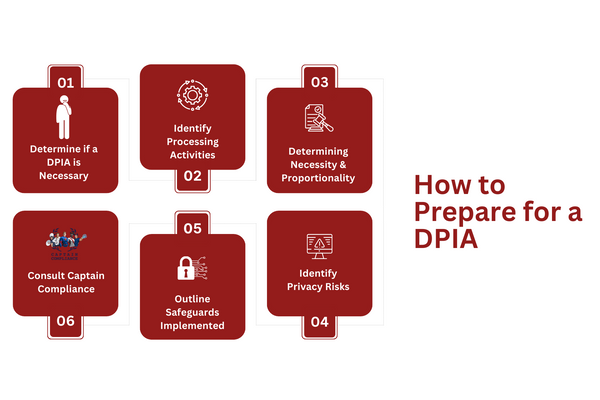
Using a DPIA template and knowing the DPIA requirements can help ensure that you are doing your DPIAs correctly.
But that’s not all businesses have to do. There are other essential steps to ensure your business is compliant with all the regulations that we’ll cover here:
Determine if a DPIA is Necessary
Not all projects or systems need a DPIA. Therefore, the first step is to establish whether your project involves processing personal data that could result in high risk for individuals’ rights and freedoms.
The EU’s GDPR recommends conducting a DPIA, particularly if you plan on:
Systematically monitoring public areas.
Conducting profiling operations where decisions and legal effects concerning an individual would be based upon automated process methods.
Processing special categories of data such as ethnicity, race, religious beliefs, health conditions, and other sensitive information on a large scale.
Processing data relating to criminal convictions and offenses at a large scale.
If the assessment shows that your project falls under these categories (or similar high-risk processing activities), then you need to conduct a DPIA.
Identify Processing Activities
Once you’ve determined the need for a DPIA, your next step is to comprehensively identify all of the data processing activities related to your project. This could include:
Collection: How will personal information be collected?
Analysis: What kind of analysis or evaluations will be processed using this personalized data?
Storage: Where and how long is it going to store that particular set of personal information?
Distribution/Sharing: To which third-party groups are planning on sharing individual’s private information?
You can use these points as guides when determining what sort of activity needs assessment while performing each task within any given project by breaking it down into smaller components accordingly.
Remember, it is vital to identify all possible processes associated with personal data, from its creation and collection through to its deletion.
This will ensure you fully understand how the information flows, where it might be vulnerable, and any potential risks that may emerge during these procedures.
Determining Necessity & Proportionality
When businesses deal with data, they function like chefs carefully selecting their ingredients. They ask themselves, “Is this necessary?” to ensure they only utilize data and safeguard privacy.
Additionally, they assess whether they are utilizing the data in a manner striking a balance between their objectives and people’s rights. It’s about conducting business practices while upholding the value of privacy.
Identify Privacy Risks
When businesses handle data, they must be aware of its value. Treat it with care.
Like planning for a trip and packing for weather conditions, they contemplate the potential risks. You must ask questions such as, “What if the data gets misplaced?” What if someone attempts to steal this data?“
By contemplating these possibilities, businesses gain insight into dangers. They compile a list of these issues not to frighten themselves but to be well prepared. Being aware of the risks enables them to plan and ensure the safety and security of everyone’s data.
Outline Safeguards Implemented
Once you become aware of risks, you don’t stop there. You roll up your sleeves and work towards finding solutions. It’s similar to spotting storm clouds and immediately reaching for an umbrella.
You should brainstorm methods to safeguard the data from any harm. One common approach is implementing encryption.
Additionally, you should focus on training to ensure that your team members are well-versed in data security practices. It’s like teaching someone how to drive before handing them the car keys.
You should also consider upgrading your computer systems to enhance security measures. The goal is to construct both small barriers that protect the data from any storms it may encounter.
Consult Captain Compliance
When businesses believe they have everything in order, it’s always wise to perform a check. It’s similar to when you’re baking and request someone to taste the dish before serving.
You can count on us to do your DPIAs for you. We provide guidance through any overlooked areas and offer tips you may not be aware of.
With our support, you can gain a level of confidence knowing that you are not only doing compliance correctly but also approaching things compliance in the most effective manner possible.
How to Prepare for a PIA
As businesses increasingly rely on processing personal data, adhering to legal guidelines and regulations has become crucial.
Preparing for a PIA can aid both compliance with state laws and certain national laws like the PIPEDA, which prevents fines and enhances a business reputation by demonstrating a commitment to protecting individual rights.
Here are some key steps for detailing precisely how one might effectively prepare for conducting a PIA:
Understand the Types of Personal Data Processed
To start off, it’s important for businesses to have an understanding of the type of data they are dealing with. Is it information, like names and addresses, or does it involve sensitive details such as health records?
By identifying the types of data they handle, businesses can create a more effective plan for managing it.
It’s similar to organizing puzzle pieces before assembling the puzzle itself. Having a picture of what you’re working with helps make the subsequent steps easier to navigate.
Identify the Purpose of Collecting Data
Understanding the purpose of collecting data is crucial. Businesses should always question the reason behind collecting data and ask themselves why they need it. It could be for enhancing customer service or providing personalized offers.
By having a purpose, businesses can ensure that they only collect data and handle personal information, with the right intentions.
Practices Used to Share Data
Businesses need to be able to clearly outline how and when they share data. Some businesses may not share personal information at all, while others might pass on details of their customers for marketing or analytics purposes.
Whatever the case, it is crucial that companies are transparent with both themselves and individuals whose private data they handle about what happens after collection – whether any sharing occurs, who has accessibility rights over this shared info (if anyone), etc.
You must also ensure these practices align perfectly well with existing local as well as state laws regarding individual privacy protection norms!
Controls Currently In Place to Safeguard Data
Prioritizing safety is crucial! It is essential for businesses to assess the measures, in place to safeguard personal data.
This may include implementing firewalls, encryption protocols and even providing training to staff members. The primary objective is to ensure that data remains secure and protected from threats such as hacks or leaks.
Closing
Navigating the realm of data protection can sometimes feel like a task. However, assessments like the DPIA and PIA can simplify the process.
These tools, along with other data compliance solutions, assist businesses in adhering to regulations and fostering trust with their consumers.
This is where Captain Compliance comes in. With their expertise in data protection compliance services, you can ensure that your data practices are compliant. Whether you’re just starting out or aiming for improvement, Captain Compliance is there to lend a hand.
If you’re seeking to outsource compliance or need help with data protection measures, don’t hesitate to reach out to us.
FAQs
What’s the difference between DPIA and PIA?
Both DPIA and PIA serve as tools for businesses to ensure the handling of data. However, DPIAs are typically associated with the GDPR regulations, and PIAs are typically used in countries like the United States and Canada.
The main difference between them lies in their applicability and specific areas of focus.
Want to see what an example of DPIA looks like? Check out an example here.
How can a business determine if it needs a DPIA or PIA?
The requirement for a Data Protection Impact Assessment (DPIA) or Privacy Impact Assessment (PIA) can vary depending on the nature of a business’s data-related activities and the regions they operate in.
For example, if a European business intends to use data in a manner that could be high risk, it is required for them to carry out a DPIA.
Conversely, businesses in the United States or Canada may choose to conduct a PIA based on projects or operational modifications.
Confused about when to conduct a DPIA or PIA? Reach out to us and we can guide you through the decision-making process!
What are the key steps in preparing for a PIA?
To get ready for a PIA, it’s important to have a grasp of the kinds of personal data being processed.
You should also understand why you’re collecting this data, how it’s shared, and what measures are in place to protect it. By going through these steps, businesses can ensure that they handle data in a compliant manner.
Need a step-by-step guide for PIA preparation? Check out our guides for more information.
How often should businesses update their data protection measures?
Ensuring the protection of data is a complex task. It is important for businesses to consistently assess and enhance their measures, particularly when adopting technologies modifying data usage practices, or adapting to changing regulations.
Regular updates are necessary to ensure compliance and effectively safeguard personal data.
Looking to update your data protection measures? Check out our guide here.